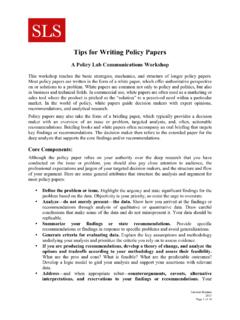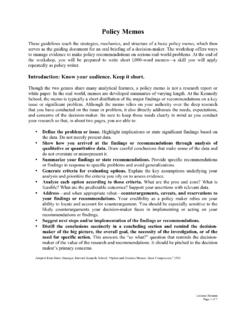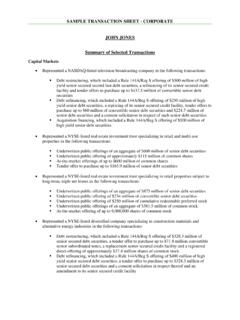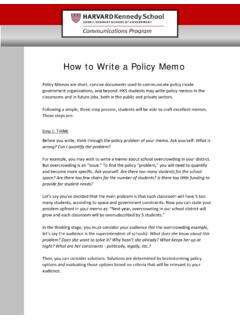Transcription of Policy Papers and Policy Analysis Briefing paper
1 Policy Papers and Policy Analysis Briefing paper : A Briefing book or Briefing paper is a distilled version of a traditional report that may resemble a long decision memo. It supplies targeted information about and Analysis of a particular subject, sometimes with Policy recommendations. It features brief sentences and paragraphs, bulleted lists, headings, subtitles, underlining, boldface, and effective use of white space as mechanisms that enhance skimmability. The bottom line is usually up front with recommendations stated first, followed by a logical breakdown of the conclusions, arguments, and evidence analyzed to reach those conclusions. These Policy Papers are briefer than traditional white Papers and present only the tip of the iceberg. They typically have many appendices that represent the supporting material , discussions of methodology, charts and graphs, regressions equations, questionnaires, survey data, focus group responses, and budget breakdowns.
2 The idea is to give your readers the choice of which material they need to digest, and when. It is important that the sections of the Briefing book be completely self-contained and able to stand alone. White paper : A white paper is an authoritative report or guide that often addresses issues and how to solve them. The term originated when government Papers were coded by color to indicate distribution, with white designated for public access. Thus, white Papers are used in politics and business, as well as in technical fields, to educate readers and help people make decisions. In commercial use, the term "white paper " has also come to refer to documents used as a marketing or sales tool. White book: a government report; bound in white A factual write-up of something, specifically devoid of the appearance of marketing; A. parliamentary document announcing government Policy A short treatise whose purpose is to educate industry customers.
3 A document containing concrete proposals for law-making in a Policy area. An official paper outlining the government's Policy on a matter to be brought before Parliament. A green paper is a more provisional document .. A white paper in a technological industry is an informational brief that offers an overview of a technology, product, issue, standard, Policy , or solution, including its importance, use and implementation, and business benefits.. A document written in essay style that provides an in-depth Analysis of a technology, trend, product or process. White Papers are predominantly informational rather than promotional material. A document containing policies for debate in Parliament. Documents published by the European Commission. White Papers contain proposals for EU action in a specific area. In some cases, they will follow a Green paper . When the European Council has favourably received a white paper , it can become the action programme for the Union in the area concerned.
4 Commercial white Papers Since the early 1990s, the term "white paper " has also come to refer to documents used by businesses as marketing or sales tools. White Papers of this sort argue that the benefits of a particular technology or product are superior for solving a specific problem. These types of white Papers are almost always marketing communications documents designed to promote a specific company's solutions or products. As a marketing tool, these Papers will highlight information favorable to the company authorizing or sponsoring the paper . Such white Papers are often used to generate sales leads, establish thought leadership, make a business case, or to educate customers. There are three main types of commercial white Papers : Business-benefits: Makes a business case for a certain technology or methodology Technical: Describes how a certain technology works Hybrid: Combines high-level business benefits with technical details in a single document Green paper From Wikipedia In the Commonwealth, the Republic of Ireland, and the United States[1] a green paper is a tentative government report of a proposal without any commitment to action; the first step in changing the law.
5 Green Papers may result in the production of a white paper . A Green paper released by the European Commission is a discussion document intended to stimulate debate and launch a process of consultation, at European level, on a particular topic. A. green paper usually presents a range of ideas and is meant to invite interested individuals or organizations to contribute views and information. It may be followed by a white paper , an official set of proposals that is used as a vehicle for their development into law. A Green paper in Canada, like a White paper , is an official document sponsored by the Crown. Green Papers tend to be statements by the government, not of Policy already determined, but of propositions put before the whole nation for discussion. They are produced early in the policymaking process, while ministerial proposals are still being formulated. Many so-called White Papers in Canada have been, in effect, Green Papers , while at least one Green paper - that on immigration and population in 1975 - was released for public debate after the government had already drafted legislation.
6 Pink paper Used in some American federal and state agencies for Policy Papers with limited internal circulation. Memo Types A memo distills a complex Policy problem or set of solutions into a two-page, 500-1000-word, summary of key points. It is intended as a short-hand substitute for the longer white paper for a busy decision maker or executive who may rely on it for meetings and roundtable discussions. Background Memo Describes the context and historical background surrounding the central problem. It may also describe key players and stakeholders, detailing their interest in the problem or the central issue. Findings Memo Like a report, a findings memo restricts itself to the facts. It resists developing options or recommendations. Options Memo Develops alternative possible Policy solutions to a particular problem in terms of costs and benefits and tradeoffs. It may resist choosing among the options, and may advocate for further research.
7 Options and Decision Memo Chooses among the options to prioritize one or more complementary recommendations. Action Memo Develops a clear Policy solution and may lay out implementation plan. Status Memo Describes the status of a research project. Data Analysis Understanding and using numbers, or statistics, and other means to show, count and compare data. Qualitative Data Analysis examines content in the form of language, words, thoughts and pictures, while Quantitative Analysis tracks or compares numbers and regressions Systematically identifying patterns in the information gathered and deciding how to organize, classify, interrelate, compare, and display it. These decisions are guided by the central research questions, the types of data available, and by input from stakeholders. Stakeholders - the individual(s) and organization(s) that will be affected by the results of the assessment or evaluation. Stakeholders may include individuals involved in program operations, those served or affected by the program, and the intended users of the assessment or evaluation.
8 The project's decision-maker, sponsor, or client is always a stakeholder. A central goal of findings is to establish stakeholder needs, concerns, and goals in the context of the overall problem. Qualitative research is a method of inquiry appropriated in many different academic disciplines, traditionally in the social sciences, but also in market research and further contexts.[1]. Qualitative researchers aim to gather an in-depth understanding of human behavior and the reasons that govern such behavior. The qualitative method investigates the why and how of decision making, not just what, where, when. Hence, smaller but focused samples are more often needed, rather than large samples. Qualitative methods produce information only on the particular cases studied, and any more general conclusions are only hypotheses (informative guesses). Quantitative methods can be used to verify, which of such hypotheses are true. Perhaps the most traditional division in the way qualitative and quantitative research have been used in the social sciences is for qualitative methods to be used for exploratory ( , hypothesis- generating) purposes or explaining puzzling quantitative results, while quantitative methods are used to test hypotheses.
9 This is because establishing content validity - do measures measure what a researcher thinks they measure? - is seen as one of the strengths of qualitative research. While quantitative methods are seen as providing more representative, reliable and precise measures through focused hypotheses, measurement tools and applied mathematics. By contrast, qualitative data is usually difficult to graph or display in mathematical terms. Qualitative research is often used for Policy and program evaluation research since it can answer certain important questions more efficiently and effectively than quantitative approaches. This is particularly the case for understanding how and why certain outcomes were achieved (not just what was achieved) but also answering important questions about relevance, unintended effects and impact of programs such as: Were expectations reasonable? Did processes operate as expected? Were key players able to carry out their duties?
10 Were there any unintended effects of the program? Qualitative approaches have the advantage of allowing for more diversity in responses as well as the capacity to adapt to new developments or issues during the research process itself. While qualitative research can be expensive and time-consuming to conduct, many fields of research employ qualitative techniques that have been specifically developed to provide more succinct, cost-efficient and timely results. Policy Analysis Policy Analysis is "determining which of various alternative policies will most achieve a given set of goals in light of the relations between the policies and the goals" [1]. However, Policy Analysis can be divided into two major fields. Analysis of Policy is analytical and descriptive . , it attempts to explain policies and their development. Analysis for Policy is prescriptive . , it is involved with formulating policies and proposals ( , to improve social welfare).



